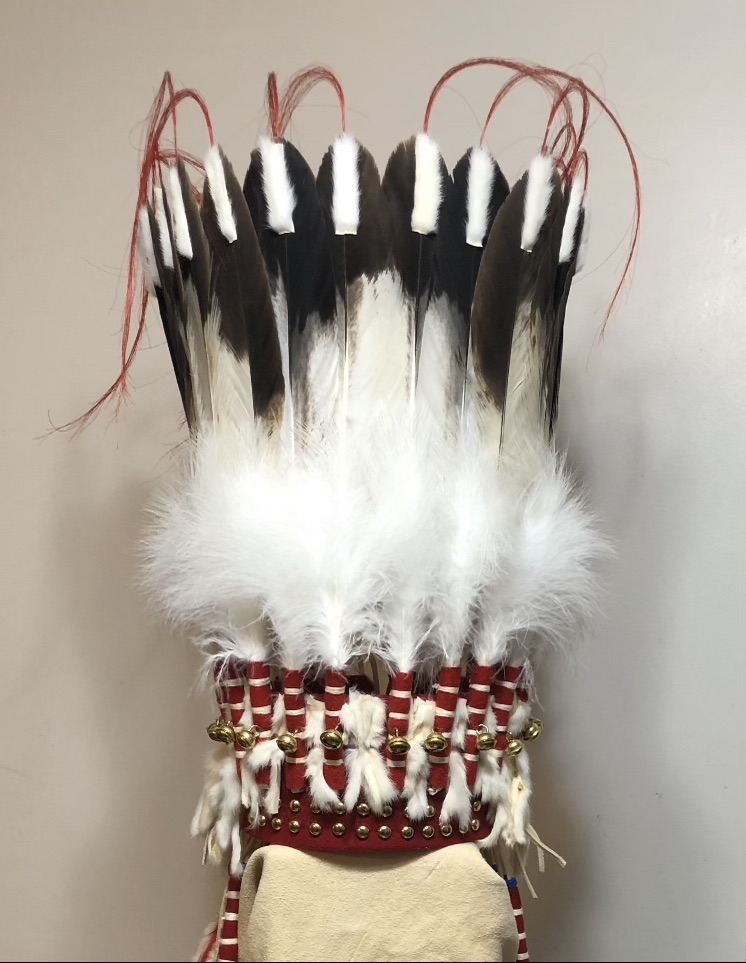CLOTHING
SAAMI- HEADDRESSES

The Straight-up Headdress is originally Blackfoot and is worn by both men and women. The headdress is fashioned with eagle feathers standing straight up. Winter weasel pelts are attached to the headband and in some headdresses, a red plume is attached to the front. Among the Siksika the Straight-up Headdress can still be seen in the Sacred Horn Society as well as the Motokik Society. Antelope Horn Headdress Some Headdresses were fashioned for personal use by warriors. This particular headdress has two antelope horns on a hat that is made from the hide of a buffalo with a single eagle feather decorated with porcupine quill work. Several horse and material goods were used as payment to own such headdresses.
Split Horn Headdress
The Split Horn Headdress was made by splitting one buffalo horn in two, attaching the horns to the side of a felt hat, and covered with winter weasel pelts some of which dangle around the hat. The Split Horn Headdress was worn by certain members of the Warrior Societies and still can be seen in some societies. One Horn Headdress This particular headdress was ritually transferred to the person who owned a tipi design that depicts a male and female serpent undulating around the bottom of the tipi. A single buffalo horn is attached to the front of a felt hat. The hat is then covered with strips of winter weasel pelts.
NIIT-TSI-TSI-KIIN- MOCCASINS
Early moccasins had soft soles and were made in one piece, folded with a side seam. This type of moccasin was known as “niit-tsi-tsi-kiin” (the true moccasin), a term that was shared among the three Blackfoot Clans.
Moccasins- Beaded
Today all moccasins are referred to in this way. The two-piece moccasin with stiff rawhide soles and soft uppers probably came into being with the advent of the horse, when nomadic people began to move in greater distances over the Prairies. Men, women, and children all wore the same style moccasin; only the size differed. Moccasins were fashioned with tanned buffalo, elk, moose, and deer hides. Later, domestic cowhides were used; a sign of hardship among Native people that meant wild game was scarce. Hides were either white or smoked, depending on their purpose. Everyday moccasins were left plain while decorated ones were used for special occasions. Porcupine quills and glass beads were commonly used. Moccasin decorations often provide spiritual protection in the form of certain symbols, which remind the wearer of sacred places, beings or teachings. These symbols face the wearer rather than the viewer. The bottoms of moccasins were also decorated for ceremonies. Blackfoot men were known to wear moccasins with beaded soles to pipe and bundle ceremonies. People sitting across from them could admire the beaded soles. Moccasins with fully beaded soles are often referred to as burial moccasins.
CLOTHING
The women’s principal garment was a sleeveless skin dress that fell to the ankles. The slip-like dress was supported by straps over the shoulders. In cold weather women wore separate skin sleeves and leggings to protect exposed flesh. Their dresses were decorated with porcupine quillwork and cut fringes. Elk and deer teeth adorned the dress and were also used for bracelets and necklaces. Colorful geometric designs painted with earth pigments decorated many women’s garments. The finest dresses, sleeves and leggings were made of antelope or mountain sheep skins. Elk and deer skins remained preferable for daily wear. As trade items began to reach the Blackfoot, changes took place in their style of dress. Women began to wear dresses with full elbow length sleeves, artfully embroidered with narrow bands of glass trade beads. Finger rings, pendants, metal bells, brass studs, and thimbles were used to decorate favorite dresses. This style remained with the Blackfoot until trade cloth gradually replaced tanned animal hides as daily clothing.
